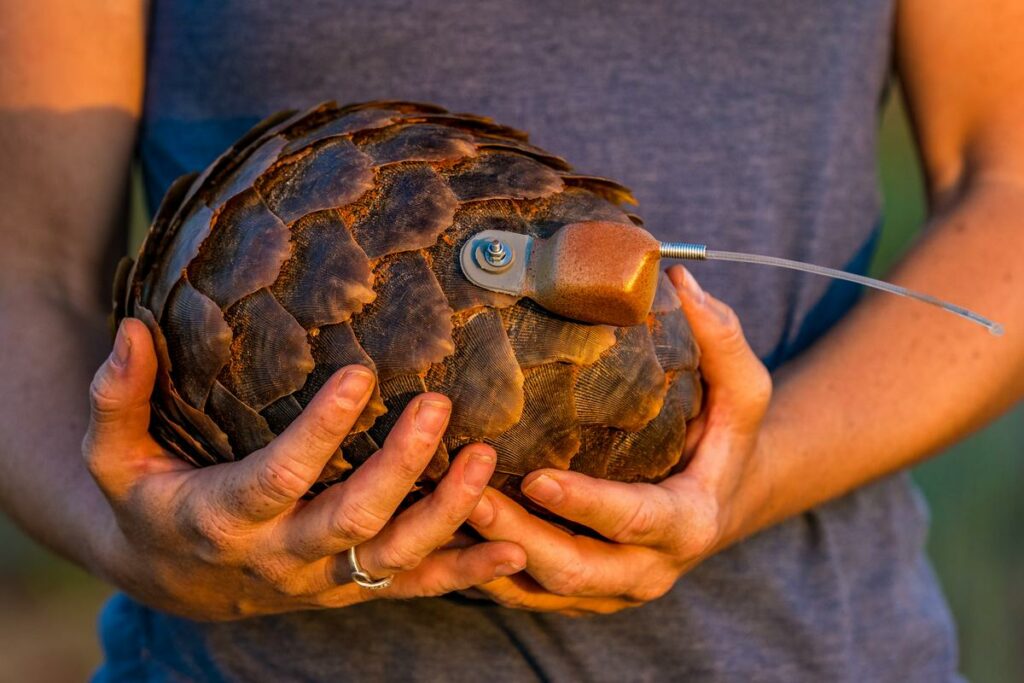Physiological ecology of Kalahari ground pangolins

PHYSIOLOGICAL ECOLOGY OF KALAHARI GROUND PANGOLIN
Principle researcher/s, Supervisors and Primary Academic Affilication:
Wendy Panaino (University of the Witwatersrand); Andrea Fuller (Wits); Graham Alexander (Wits)
Wendy Panaino:
For her PhD studies at the University of the Witwatersrand, Wendy Panaino spent four years investigating the responses of ground pangolins (Smutsia temminckii) at Tswalu Kalahari to seasonal and yearly fluctuations in climatic conditions and food resources.
Ground pangolins are myrmecophagous (ant and termite-eating), burrowing mammals that occur only in eastern and southern Africa, including in the already hot and dry Kalahari region of South Africa. As a result of climate change, regions of Africa, including the Kalahari, are becoming hotter and drier. Such changes can impact mammals directly, primarily by increasing the heat load to which they are exposed, as well as indirectly, for example by impacting their food resources. Whether most mammals will be able to cope with such changes to their environment is unknown.
Pangolins are elusive and predominantly nocturnal animals, making it challenging to study them. Very little is therefore known about their ecology and physiology. With the support of Tswalu staff, the Tswalu Foundation, her supervisors professors Andrea Fuller and Francesca Parrini, as well as an experienced veterinary team, Wendy studied the responses of free-living pangolins equipped with miniature body temperature data loggers and VHF tracking transmitters. She also gathered long-term data on the food resources available to pangolins and investigated what the pangolins ate through behavioural observations and analyses of pangolin scats. By monitoring specific individual pangolins, Wendy has been able to gain unique insights into the lives of one of the world’s most secretive mammals.
Understanding the ecology and physiology of ground pangolins at Tswalu will not only provide insight into how these elusive Kalahari animals may cope in future, but will provide an analogue for how they might respond to climate change in other regions of Africa, where hotter and drier conditions are also becoming more common. The insights gained from the research will contribute to informed decision-making and management practices, ultimately improving the conservation efforts of a species already threatened by habitat loss and the illegal wildlife trade.
KEY RESEARCH OBJECTIVES:
- – Complete PhD
- – Publish two papers
- – Monitor pangolin activity, diet, and movement
- – Assess insect abundance and vegetation (grass cover, grass height, tree volume, trees phenology)
- – Monitor and measure dung beetle activity and morphology
PROGRESS UPDATE AND KEY FINDINGS FROM 2021:
- – PhD officially awarded in July 2021.
- – Published one pangolin paper and have submitted another paper on an observation between a Cape fox and a polecat to the Journal of African Ecology.
- – Pangolin activity, diet and movement has been monitored for 2021 and will continue into 2022. Interesting observations (although expected after the good summer rainfall in 20210, includes pangolins remaining nocturnal throughout the winter season, which is an indication of good energy status of the pangolins. Also, of the two female pangolins we have been monitoring, one gave birth to a pup in September 2021. The second female lost her tag, but her behaviour prior to losing her tag suggested that she may have been pregnant or had a pup, likely also in September 2021. One of my objectives in 2022 will be to relocate the lost female, as her home range is well known. The pup (born in September 2020) that was tagged in April 2021 had left her natal home range early in May, remained in a new area (next to her natal home range) for six months, and then dispersed approximately 12km east. She seemed to have settled once she located a termite mound in which to sleep in the hills.
- – We have continued to assess insect abundance and vegetation throughout 2021. Insect numbers appear to have made an excellent recovery, with winter numbers in 2021 exceeding the numbers recorded in some of the previous summers. Although the numbers have not yet been analysed for this summer, anecdotal evidence suggests that numbers are very high so far for the summer. Leslie Brown recently joined me at Tswalu to put more detailed vegetation monitoring in place for trees (tree volume and phenology). We have selected the sites, which overlap with existing insect transects, and the measurements will commence in 2022.
Note: In May 2021, we also found a tagged pangolin that had been electrocuted on a fence. This pangolin had a GPS data logger (attached in December 2020), and a body temperature data logger (implanted in 2015). Both data loggers were retrieved, and the data downloaded. The GPS data logger revealed that the pangolin had safely crossed the fence in and out of Lekgaba six times (double fence along the district road means 12 successful crossings) within 22 days. Often, I was not able to locate this pangolin and I had suspected it was moving in and out of Legkaba. It is highly likely that it successfully moved across the double fence many times during the five years that it was tagged. The body temperature data logger revealed that body temperature was successfully and accurately recorded at 5-minute intervals for almost three years. This is very likely the longest, continuous dataset of body temperature for any wild mammal.
– – – – – – – – – – – – – – – – – – – –
GET INVOLVED
Use our secure online portal to make a donation to the Tswalu Foundation Trust in support of the sustainability of ongoing research management of the many projects supported by the foundation, its researchers and various activities.
DONATE
